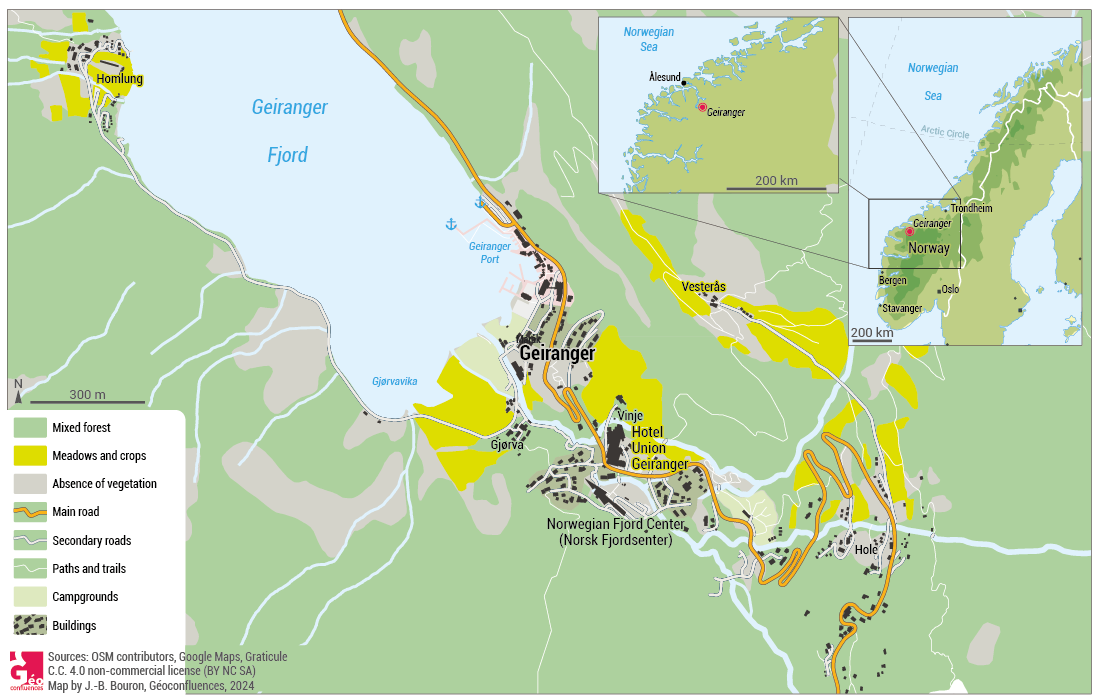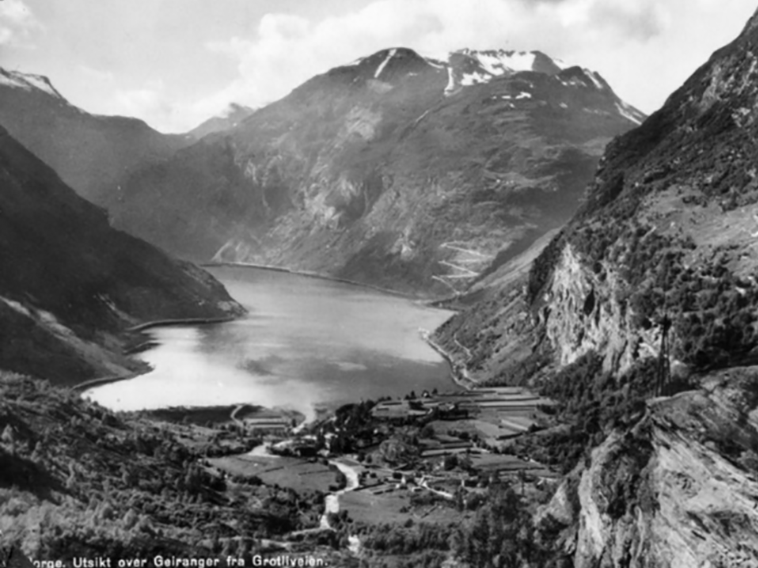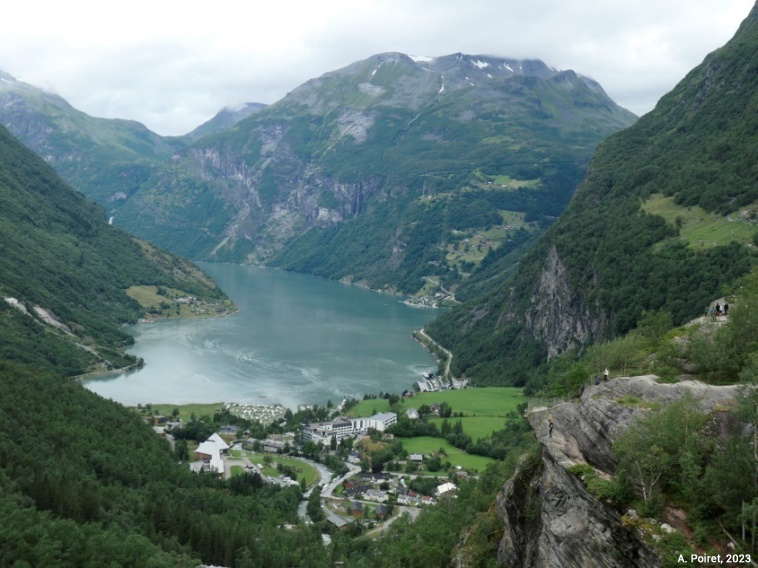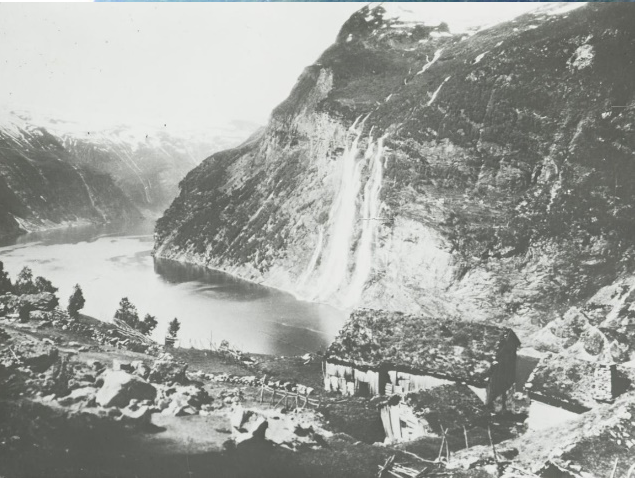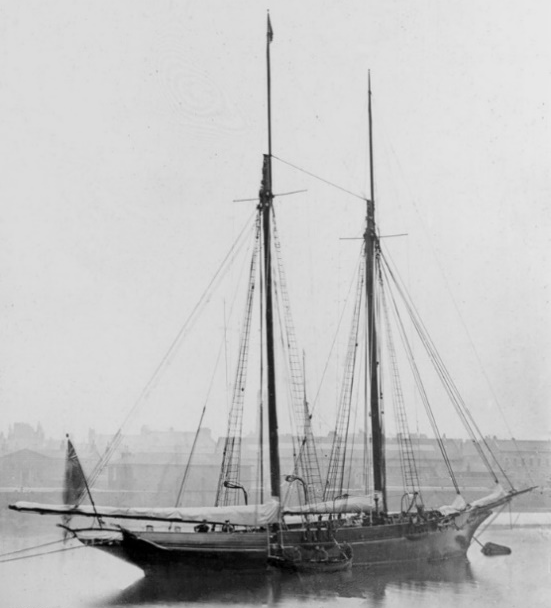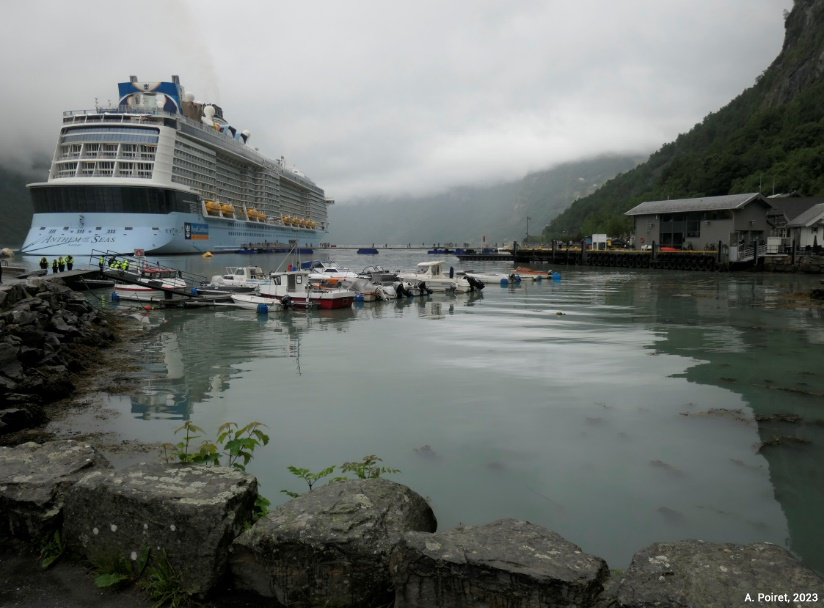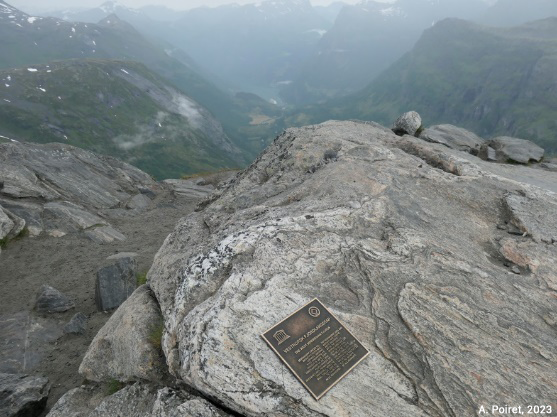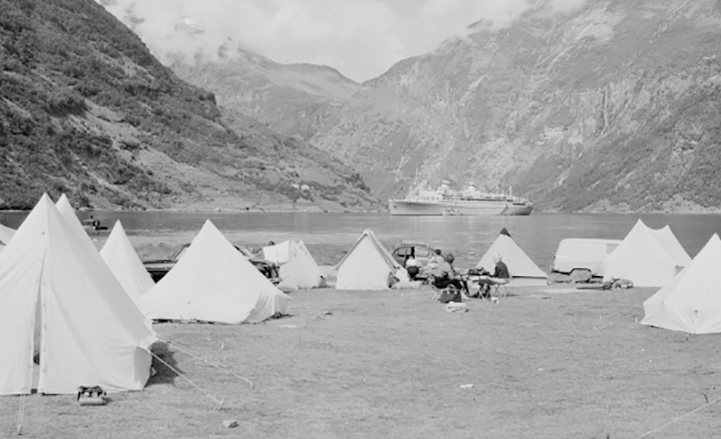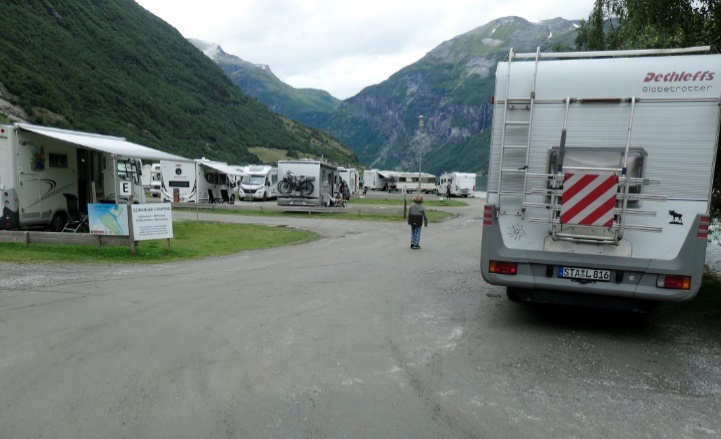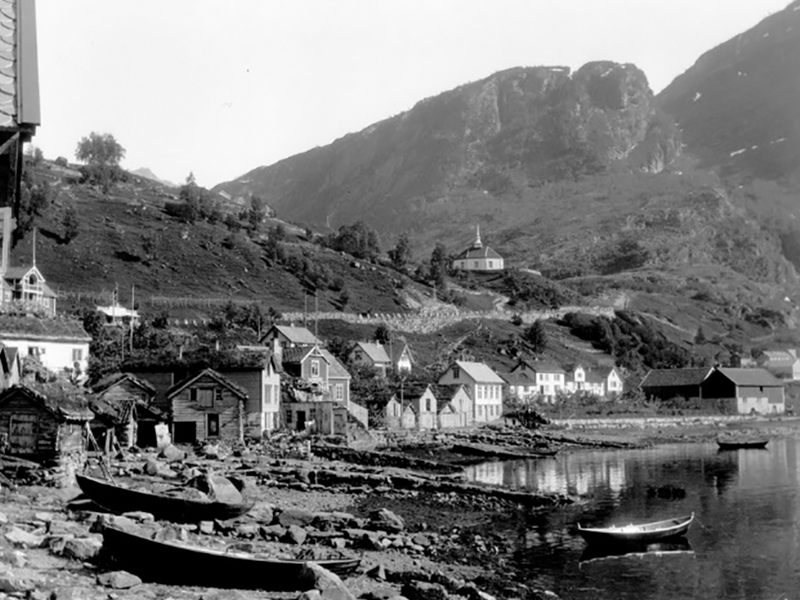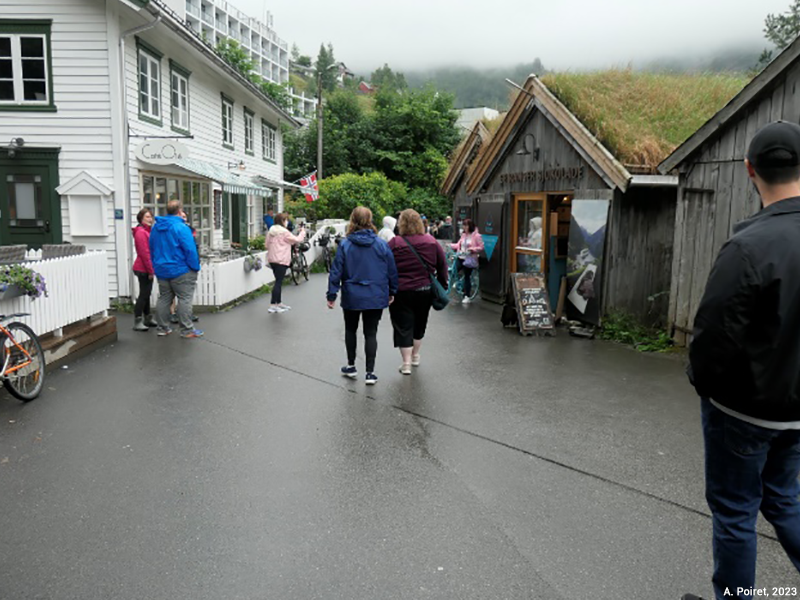The Long-Term Growth of Tourism at a Site Now Designated as a World Heritage Site, the Geirangerfjord in Norway
- Sommaire
References | citation |  English |
English |  français
français
This article explores the touristic development of the Geirangerfjord, a site listed as a UNESCO World Heritage site in 2005. Located in the municipality of Stranda, at the heart of the Sunnmøre region in Norway, Geiranger is approximately 100 kilometers away from Ålesund, situated at the fjord's outlet to the ocean, and about 300 kilometers from Bergen, further south along the coast. Nestled at the end of the fjord is the village of Geiranger, which has around 250 to 300 residents in winter but experiences a significant tourist influx during the summer season, from May to September. Could the tourist appeal and high visitor numbers lead to over-tourism? The diachronic comparison of Geiranger's landscapes and the fjord revisits the village's economic development, from the inception of tourism in 1869 to the present rise of mass tourism. In addition to quantitative data and existing literature, this research draws on a series of non-directive interviews conducted using a participative immersion approach within the UNESCO site's visitor center.
Document 1. Location map
|
The two photographs in document 2 depict the fjord and the village from the vantage point of Flydalsjuvet, with the first taken in 1878 and the second in 2023. The tourist development of the area is evident, notably marked by the appearance of new constructions along the coastline and in the valley. Access to this viewpoint is now possible by car, thanks to improved road infrastructure. The Geiranger camping site has expanded and is visible from the viewpoint, while the Norwegian Fjord Center (Norsk Fjordsenter), recognizable by its arrow-shaped roof, has replaced agricultural land. Souvenir shops have taken residence in the former boathouses. The development of one of the city's main hotels, the Union Geiranger Hotel, which now includes multiple buildings, is also clearly visible in the 2023 photograph.
Document 2. Geiranger, the fjord and the village, in 1878 and in 2023 |
|
|
2a. Geiranger from Flydalsjuvet. Photograph by Berh B. OPPI, 1878, source: Hardangerand Voss Museum. |
2b. Geiranger from Flydalsjuvet. Photo by Andréa Poiret, 2023. |
1. An Isolated Territory Made Easily Accessible...
The Geirangerfjord was designated a UNESCO World Heritage site in 2005, along with another fjord, the Nærøyfjord, together recognized as the "Fjords of Western Norway" for their exceptional glacial landscapes. These two fjords in Western Norway are distinguished by their geological features, including steep cliffs and monumental waterfalls resulting from glacial activity. They serve as a valuable field of study to understand the influence of glaciers on landscape formation. Additionally, the agricultural remnants of this territory are considered culturally significant by UNESCO. Over a hundred traditional farms perched at high altitudes along the fjord bear witness to Norwegian agricultural life in this secluded mountainous region. The rehabilitation of these farms provides tourists with access to elements of popular culture while potentially stereotyping them, risking the process of folklorization.
Document 3. Skageflå Farm, during the first half of the 20th century and in 2023 |
|
|
3a. Skageflå farm, 1900-1940. Source: National Library of Norway |
3b. Skageflå farm, photo by Andréa Poiret, 2023. |
The territory has been shaped by tourism, perhaps even constructed for it, as evidenced by the numerous vintage postcards. The fjord offered various opportunities to tourists as early as the 1860s with the establishment of the first hotel and guesthouses. The abundance of vintage postcards suggests that this touristic territory has evolved over the long term. In 1869, the first visitors arrived by boat, including the English banker Edward Backhouse and his family aboard the yacht Nereid (document 4), highlighting the pioneering role of the British, the first tourists even before the development of tourism (Knafou and Fournier, 2023). This was an eminently elitist practice in the 19th century that connected different European locations, from the English Channel or the French Riviera to the French or Swiss Alps.
The lives of the villagers were disrupted from the beginning of touristic activity in the village. By 1888, the number of tourist-filled ships had already reached 39, and in 1905, around a hundred cruise ships docked in Geiranger each year. Since then, a regular ferry service has been established to allow visitors to reach the village from the city of Ålesund, providing a three-hour experience at the heart of the fjord landscapes. These ferries make stops in front of the famous fjord waterfalls, including the "Seven Sisters" and their "Suitor".
Document 4. From yacht to cruise ship, and from the British elite to mass tourism |
|
|
|
4a (left). Nereid yacht, 1869. Source: www.storfjord1.no 4b (ci-dessus). Cruse ship in Geiranger. Photo by Andréa Poiret, 2023. |
Once on site, today's tourists have access to a variety of activities. They can start by visiting the Norwegian Fjord Center (document 1), a visitor’s center that houses a museum showcasing UNESCO-listed sites worldwide, along with exhibitions, one dedicated to the region's heritage and another to air pollution. To reach the center, they can take the Fossevandring trail along the Storfossen waterfall. The hiking trails on the UNESCO site are well-marked, with the symbol’s "V" (for "Verdensarven", World Heritage in Norwegian) painted along the paths. Some of these hiking trails lead to postcard-perfect farms. It is also possible to rent bicycles, and a company even offers two-seater electric cars. Among the other recreational activities offered at the site are boat trips in semi-rigid inflatables or kayaking in the fjord, rock climbing on a via ferrata, a visit to the local chocolate factory, and a craft beer tasting at one of the village restaurants.
Document 5. From artisanal and industrial tourism (carts and steamships, 1938-40) to globalized tourism (UNESCO inscription in 2005) |
|
|
5a. Horse-drawn carriages on the beach and steamship on the fjord. Photo by Merok E., Mittet & Co, source: National Library of Norway, 1938-1940. |
5b. UNESCO plaque at Dalsnibba. photo by Andréa Poiret, 2023. → About UNESCO plaque, read [in French] Gauchon et al., « Rendre visible le patrimoine mondial. Ce que révèlent les plaques commémoratives des biens inscrits sur la Liste de l'UNESCO », 2021. |
2. ... And Confronted by Intense Tourist Pressure
This UNESCO World Heritage site is under considerable tourist pressure, with cruise ships making daily stops at the village. In 2019, Geiranger hosted 402,335 cruise passengers, making it Norway's 3rd most visited destination (Cruise Norway, 2020). This is 1300 times the winter population of the village.
Even though large steamships were already docking in the fjord in the 1930s (document 5), the size of the vessels, their capacity, and the frequency of arrivals have significantly increased. As a result, local port authorities have set a limit of 6000 cruise passengers per day in Geiranger and Hellesylt (Norwegian Maritime Authority, 2017). This tourism is concentrated during the tourist season from June to late September, relying primarily on seasonal workers, as attested by a souvenir shop owner:
| « |
|
» |
In addition to cruise ships, many tourists arrive by land in caravans, vans, and cars. Some stay overnight in one of the five hotels or ten campsites in the village, while others opt for wild camping or park their vehicles along the roadside. As a result, the two narrow village roads are regularly congested on days with high arrivals. This influx can be perceived as a nuisance by some residents, as described by an employee of a tourist company:
| « |
|
» |
Document 6. From Tents (1950) to Campervans (2023) |
|
|
6a. Camping in Geiranger in 1950. Photograph: FotoJacBrun, source: National Library of Norway |
6b. Geiranger Camping. Photo by Andréa Poiret, 2023 |
In Geiranger, the increasing number of tourists has sparked a debate about the negative consequences of mass tourism, especially cruise tourism (Shlopak et al., 2014; Norwegian Maritime Authority, 2017). Depending on their size and the number of passengers, cruise ships can generate significant amounts of waste and be a source of various other pollutants (Norwegian Maritime Authority, 2017; Simonsen et al., 2019) that contaminate the environment and pose health risks [1]. This results in substantial emissions: 416,132 tons of CO2, 7184 tons of nitrogen oxides, and 132 tons of fine particles (PM2.5) in Norway in 2017, approximately 589 kg of CO2 per passenger for a journey of about 985 nautical miles (1824 km) in Norwegian waters (Simonsen et al., 2019), assuming 6000 passengers per ship as a reference. Thus, the approximate amount of CO2 emitted per kilometer and per cruise passenger is around 323 grams. For comparison, a trip by TGV (high-speed train) produces about 2.4 grams of CO2 per kilometer, while a gasoline car emits about 250 grams per kilometer.
Nuisances, such as road and parking congestion or noise and air pollution, raise the issue of over-tourism (Mihalic, 2020) in Geiranger. Over-tourism is defined by the World Tourism Organization (UNWTO) as "the impact of tourism on a destination, or certain parts of it, that excessively influences the perceived quality of life by citizens and/or the quality of experiences of visitors in a negative way" (UNWTO, 2018; Capocchi et al., 2019; Mihalic, 2020). Cruise ships bring an influx of tourists over a short period, concentrated over four months, causing congestion in the area but generating significant revenue through these activities (Capocchi et al., 2019; Poiret, 2020). In Norway, the maritime sector plays a crucial role in the country's economy (Reve et Sasson, 2012), with approximately 3 million visits per year. The country is considered the primary cruise destination in Northern Europe (Simonsen et al., 2019).
Document 7. Geiranger Tourist Village in 1909 and 2023 |
|
|
7a. Geiranger in 1909. Photograph by Anders Bear WILSE, source: Norwegian Folk Museum |
7b. Geiranger in 2023, photo by Andréa Poiret |
3. Limiting Emissions for Cruise Ships and Tourist Boats to Address the Consequences of Tourist Attraction
Facing the growing concern about CO2 emissions from the maritime sector, which is not covered by the Paris Agreement (Traut et al., 2018), Norway aspires to position itself as a global leader in environmentally friendly maritime transport (Simonsen et al., 2019). In this context, the Norwegian government has decided to implement low and zero-emission solutions in the maritime industry by 2030 (Norwegian Parliament, 2018; Simonsen et al., 2019). To achieve these goals, the Parliament has instructed the government to implement regulations to ensure the introduction of zero-emission requirements for tourist boats and ferries in the World Heritage fjords by no later than 2026 (Norwegian Parliament, 2018).
The potential consequences of this decision on local income and quality of life concern economic stakeholder’s dependency on cruise tourism in Geiranger. According to the Menon agency, responsible for the socio-economic analysis of introducing a zero-emission requirement, the use of liquid biofuel and biogas could lead to a decrease in tourism-related growth in Geiranger and Flåm from 78 to 101 million Norwegian kroner, with the loss of 131 to 171 jobs. An absolute zero-emission requirement would result in a decrease of 109 million Norwegian kroner and the loss of 184 jobs.
A major concern involves the modal shift to alternative means of transportation, such as buses, in case of restrictions on cruises, which could exacerbate road congestion issues without the direct economic benefits associated with cruise ships, as explained by a souvenir shop owner:
| « |
|
» |
Some view cruise tourism as an integral part of Geiranger's cultural identity and fear its complete disappearance:
| « |
|
» |
Others call for government and municipal support to facilitate this transition, emphasising that concrete actions must be taken to ensure the economic survival of the region, as highlighted by a hotel owner:
| « |
|
» |
However, some businesses see this decision to restrict emissions as an opportunity to strengthen their activities. This is the case with Hurtigruten Expedition, which positioned itself in 2019 in the emissions-free cruise market by introducing the world's first hybrid battery-powered cruise ship, the MS Roald Amundsen, capable of operating without emissions for short periods. Regarding the Geirangerfjord, Norwegian Hydrogen has decided to invest in a complete hydrogen production and processing plant, partially funded by Innovation Norway and the Norwegian Research Council. This plant is expected to provide 1300 kg of green hydrogen per day, with a focus on supplying maritime vessels in the UNESCO World Heritage area of the Geirangerfjord. In addition, the Norwegian University of Science and Technology (NTNU) collaborates with the municipality of Stranda (responsible for the village of Geiranger) on a "green quays" project aimed at supplying ships with electricity from the shore through recharge points. However, the construction of "zero-emission" ships and the production of renewable fuels, such as biogas, still generate greenhouse gas emissions, especially if an entire fleet needs to be renewed.
Conclusion
Opinions are divided on how this transition will impact the local tourism industry, with some supporting the initiative for environmental reasons, while others express concerns about potential economic consequences on local income. However, Geiranger faces a crucial lack of infrastructure, despite the massive increase in tourism. The absence of sufficient camping facilities and hotels during the peak season, especially in June, results in space saturation, exacerbated by narrow roads ill-suited for the growing influx of cars and buses. Residents express concern about the municipality's perceived inadequate response to over-tourism, citing issues such as waste management and lack of parking. Some support the idea of a parking project, albeit expensive and environmentally unfriendly, while others highlight specific challenges related to essential services, including medical care, facing an already financially limited community.
While considering the future and well-being of future generations, which requires a rapid reduction in greenhouse gas emissions, the population of Geiranger faces specific challenges, especially regarding the availability of certain essential services such as medical care. Residents and entrepreneurs share concerns about the municipality's ability to address these current problems with limited resources, signalling a pressing need for investment and logistical solutions to ensure the sustainability and future well-being of Geiranger.
Bibliography
- Capocchi,A., Vallone C., Pierotti M., Amaduzzi A., 2019, "Overtourism: A Literature Review to Assess Implications and Future Perspectives", Sustainability, 11.
- Ćelić J., Valčić S., Bistrović M., 2014, "Air pollution from cruise ships," Proceedings ELMAR-2014, Zadar, Croatia, pp. 1-4.
- Cruise Norway, 2020, Cruise Calls and Pax to Norway.
- Grenier A. A., 2008, « Le tourisme de croisière », Téoros, 27-2.
- Innovation Norway, 2019, Nøkkeltall cruise 2017–2018 – En oversikt over norsk cruisenaering.
- Klein R.A., 2009, "Getting a Grip on Cruise Ship Pollution", Friends of the Earth, 58p.
- Klein, R.A., 2011, Responsible Cruise Tourism: Issues of Cruise Tourism and Sustainability, J. Hosp. Tour. Manag. 18, 107–116.
- Knafou Rémy et Fournier Carine, « Le système touristique mondialisé en question », Géoconfluences, novembre 2023.
- Mihalic T., 2020, "Conceptualising overtourism: A sustainability approach", Annals of Tourism Research, volume 84.
- Norwegian Parliamient, 2018, Klimastrategi for 2030—Norsk Omstilling i Europeisk Samarbeid, E.-A.E. Committee: Oslo, Norway
- Norwegian Maritime Autority, 2017, Pollution from ships in fjord areas with heavy cruise traffic, Report 5 May 2017. Rev. 1, 40 p.
- OMT (UNWTO), 2018, "Overtourism'? – Understanding and Managing Urban Tourism Growth beyond Perceptions", World Tourism Organization (UNWTO); Centre of Expertise Leisure, Tourism & Hospitality; NHTV Breda University of Applied Sciences; and NHL Stenden University of Applied Sciences (2018),
- Poiret A., 2020, « Le fjord d’Ilulissat (Groenland), site classé patrimoine mondial de l’UNESCO, étude de cas d’une patrimonialisation », Géoconfluences.
- Reve, T., Sasson, A., 2012, Et kunnskapsbasert Norge, Oslo, Ed. Universitetsforlaget, 389 p.
- Shlopak M., Bråthen S., Svendsen H.J., Oterhals O, 2014, Beregning av Klimagassutslipp i Geiranger, Grønn Fjord. Bind II. Møreforsking Molde AS: Molde, Norway.
- Simonsen M., Walnum H.J., Gössling S., 2018, "Model for Estimation of Fuel Consumption of Cruise Ships", Energies 11, 1059.
- Simonsen M., Gössling S., Walnum H.J., 2019, “Cruise ship emissions in Norwegian waters: A geographical analysis”, Journal of Transport Geography, volume 78, pages 87–97,
- Traut M., Larkin A., Anderson K., McGlade C., Sharmina M., Smith T., 2018, “CO2 abatement goals for international shipping”, Climate Policy, 1-10.
Andréa POIRET
Independent researcher - former student at Université Paris I Panthéon-Sorbonne
Traduction by the author, reviewed and corrected by Jessica-Rose Tatham, Marion Coste and Charlotte Musselwhite-Schweitzer.
web layout : Jean-Benoît Bouron
Cite this text:
Andréa Poiret, « The Long-Term Growth of Tourism at a Site Now Designated as a World Heritage Site, the Geirangerfjord in Norway », Géoconfluences, January, 2024. Translated from French by author in June 2024.
URL: https://geoconfluences.ens-lyon.fr/programmes/dnl/dnl-hg-anglais/fjord-geiranger-norway



 Mode zen
Mode zen